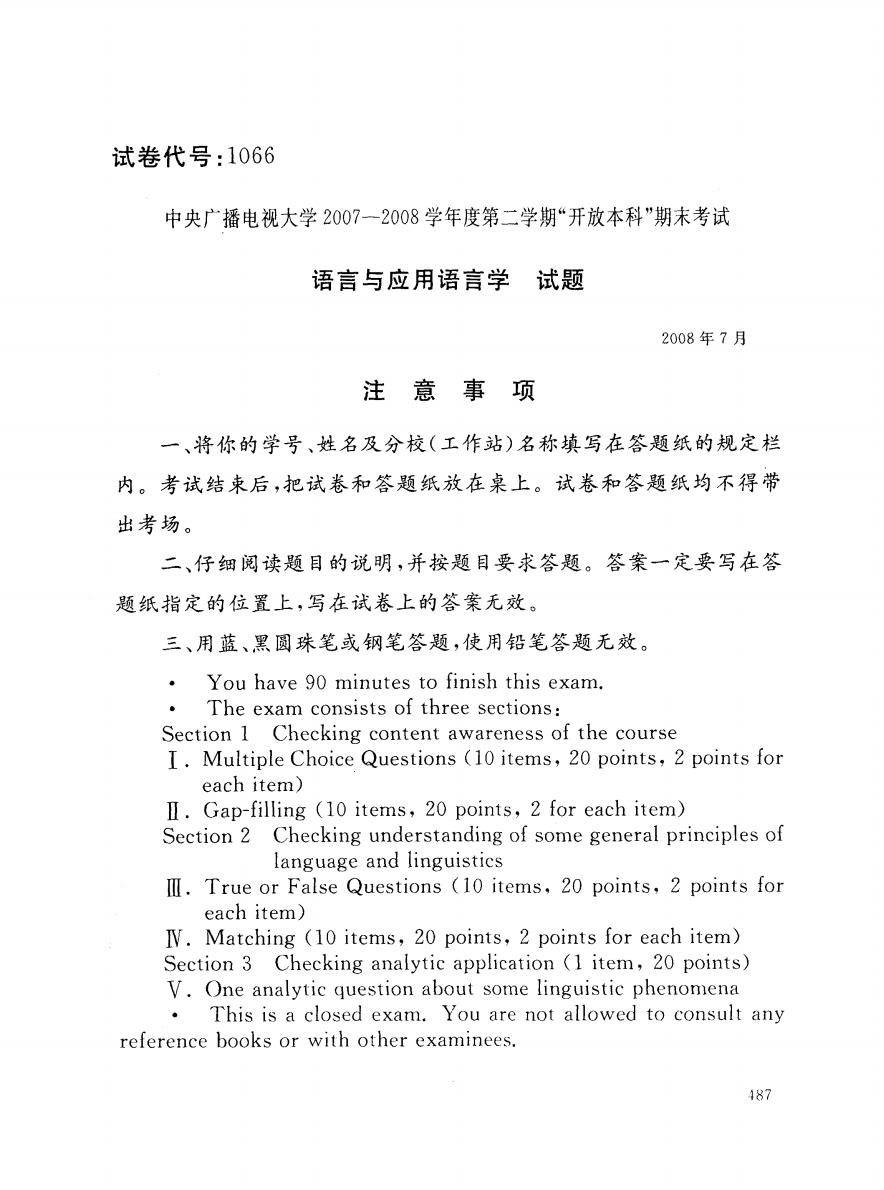
试卷代号:1066 中央广播电视大学2007一2008学年度第二学期“开放本科"期末考试 语言与应用语言学试题 2008年7月 注意事项 一、将你的学号、姓名及分校(工作站)名称填写在答题纸的规定栏 内。考试结束后,把试卷和答题纸放在桌上。试卷和答题纸均不得带 出考场。 二、仔细阅读题目的说明,并按题目要求答题。答案一定要写在答 题纸指定的位置上,写在试卷上的答案无效。 三、用蓝、黑圆珠笔或钢笔答题,使用铅笔答题无效。 You have 90 minutes to finish this exam. The exam consists of three sections: Section 1 Checking content awareness of the course I.Multiple Choice Questions(10 items,20 points,2 points for each item) II.Gap-filling (10 items,20 points,2 for each item) Section 2 Checking understanding of some general principles of language and linguistics II.True or False Questions (10 items,20 points,2 points for each item) IV.Matching (10 items,20 points,2 points for each item) Section 3 Checking analytic application (1 item,20 points) V.One analytic question about some linguistic phenomena This is a closed exam.You are not allowed to consult any reference books or with other examinees. 187
试卷代号 :1066 中央广播电视大学2007-2008学年度第二学期“开放本科”期末考试 语言与应用语言学 试题 2oas年 z月 之闷卜 尽 .目罗 T口; i土 E己 畏归. 刁 之 一、将你的学号、姓名及分校(工作站)名称填写在答题纸的规定栏 内。考试结束后,把试卷和答题纸放在桌上。试卷和答题纸均不得带 出考场。 二、仔细阅读题 目的说明,并按题目要求答题。答案一定要写在答 题纸指定的位置上,写在试卷上的答案无效。 三、用蓝、黑圆珠笔或钢笔答题,使用铅笔答题无效。 You have 90 minutes to finish this exam. The exam consists of three sections: Section 1 Checking content awareness of the course I.Multiple Choice Questions(10 items,20 points,2 points for each item) fl.Gap-filling(10 items,20 points,2 for each item) Section 2 Checking understanding of some general principles of language and linguistics m.True or False Questions(10 items,20 points,2 points for each item) W.Matching(10 items,20 points,2 points for each item) Section 3 Checking analytic application(1 item,20 points) V.One analytic question about some linguistic phenomena This is a closed exam. You are not allowed to consult any reference books or with other examinees. 487
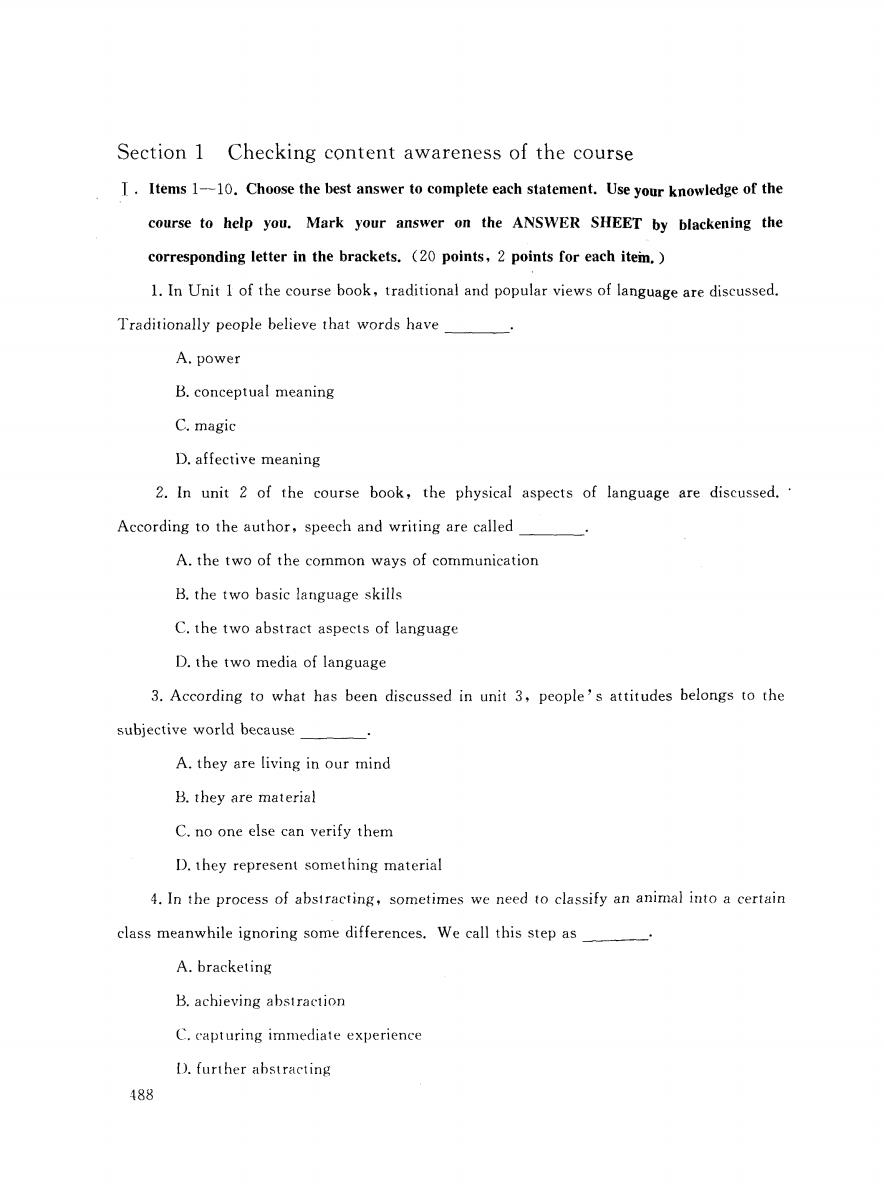
Section 1 Checking content awareness of the course I.Items 1--10.Choose the best answer to complete each statement.Use your knowledge of the course to help you.Mark your answer on the ANSWER SHEET by blackening the corresponding letter in the brackets.(20 points,2 points for each item. 1.In Unit 1 of the course book,traditional and popular views of language are discussed. Traditionally people believe that words have A.power B.conceptual meaning C.magic D.affective meaning 2.In unit 2 of the course book,the physical aspects of language are discussed.' According to the author,speech and writing are called A.the two of the common ways of communication B.the two basic language skills C.the two abstract aspects of language D.the two media of language 3.According to what has been discussed in unit 3,people's attitudes belongs to the subjective world because A.they are living in our mind B.they are material C.no one else can verify them D.they represent something material 4.In the process of abstracting,sometimes we need to classify an animal into a certain class meanwhile ignoring some differences.We call this step as A.bracketing B.achieving abstraction C.capturing immediate experience D.further abstracting 488
Section 1 Checking content awareness of the course I.Items 1一10, Choose the best answer to complete each statement. Use your knowledge of the course to help you. Mark your answer on the ANSWER SHEET by blackening the corresponding letter in the brackets. (20 points, 2 points for each item,) 1. In Unit 1 of the course book,traditional and popular views of language are discussed. Traditionally people believe that words have_ . A. power B. conceptual meaning C. magic l. affective meaning 2. In unit 2 of the course book,the physical aspects of language are discussed.‘ According to the author, speech and writing are called_ . A. the two of the common ways of communication I3. the two basic language skills C. the two abstract aspects of language D. the two media of language 3. According to what has been discussed in unit 3,people’s attitudes belongs to the subjective world because A. they are living in our mind B. they are material C. no one else can verify them U. they represent something material 4. In the process of abstracting, sometimes we need to classify an animal into a certain class meanwhile ignoring some differences. We call this step as_ · A. bracketing l3. achieving abstraction C. capturing immediate experience l. further abstracting 488

5.Speech Act theory was firstly put forward by A.J.L.Austin B.Leech C.Noam Chomsky D.Clark &Clark 6.In Unit 6,the course book maintains that we can use language to manage interpersonal relations.Which one of the following is the evidence of the concept? A.making a request B.using abstract language C.face work D.classroom talk 7.Among the following,what is NOT discussed in Unit 7? A.given information and given-off information B.the safe topics for talking C.Chinese politeness D.the hearer roles 8.The four types of identity that are covered in Unit 8 are A.national identity,religious identity,career identity and status identity B.national identity,regional identity,rank identity and status identity C.national identity,religious identity,family identity and gender identity D.national identity,regional identity,status identity and gender identity 9.Which of the following theories is NOT discussed in Unit 9? A.the critical period for language hypothesis B.Linguistic Imperialism C.the theory of schema D.long term memory and short term memory 10.This course requires a learner to deal with three different tasks.They are A.awareness tasks,understanding tasks and analytic tasks B.awareness tasks,application tasks and analytic tasks C.understanding tasks,application tasks and analytic tasks D.awareness tasks,understanding tasks and application 489
}. Speech Act theory was firstly put forward by A. J. L. Austin 13. Leech C. Noam Chomsky D. Clark& Clark 6. In Unit 6,the course book maintains that we can use language to manage interpersonal relations. Which one of the following is the evidence of the concept?_ A, making a request B. using abstract language C. face work D, classroom talk 7. Among the following, what is NOT discussed in Unit 7?_ A. given information and given-off information B. the safe topics for talking C. Chinese politeness D. the hearer roles 8. The four types of identity that are covered in Unit 8 are_ . A. national identity, religious identity,career identity and status identity 13, national identity,regional identity, rank identity and status identity C. national identity,religious identity, family identity and gender identity D. national identity, regional identity, status identity and gender identity 9. Which of the following theories is NOT discussed in Unit 9}_ A. the critical period for language hypothesis B. Linguistic Imperialism C. the theory of schema D. long term memory and short term memory 10. This course requires a learner to deal with three different tasks. They are_ . A. awareness tasks,understanding tasks and analytic tasks 13. awareness tasks,application tasks and analytic tasks C. understanding tasks,application tasks and analytic tasks D. awareness tasks,understanding tasks and application 489
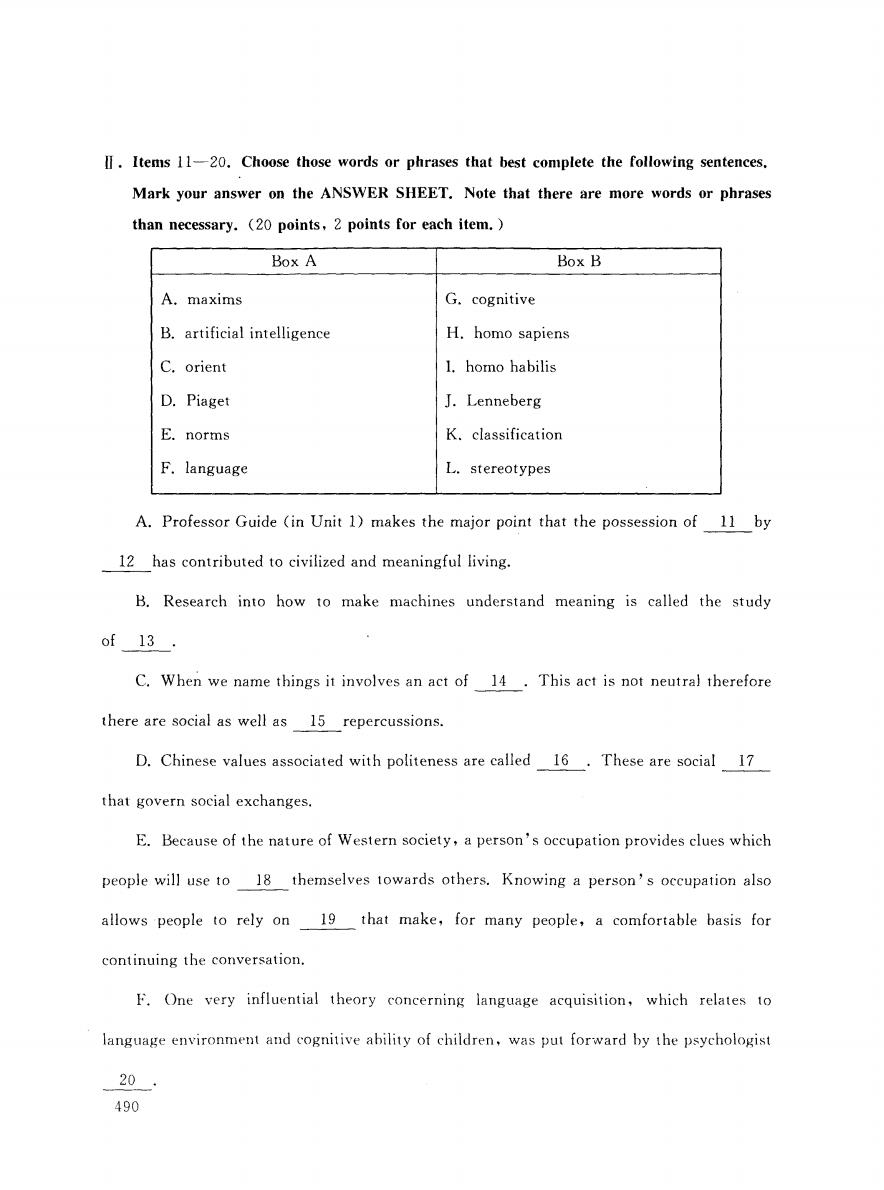
II.Items 11-20.Choose those words or phrases that best complete the following sentences. Mark your answer on the ANSWER SHEET.Note that there are more words or phrases than necessary.(20 points,2 points for each item. Box A Box B A,maxims G. cognitive B.artificial intelligence H.homo sapiens C.orient 1.homo habilis D.Piaget J.Lenneberg E.norms K.classification F.language L.stereotypes A.Professor Guide (in Unit 1)makes the major point that the possession of 11 by 12 has contributed to civilized and meaningful living. B.Research into how to make machines understand meaning is called the study of 13. C.When we name things it involves an act of 14.This act is not neutral therefore there are social as well as 15 repercussions. D.Chinese values associated with politeness are called 16.These are social 17 that govern social exchanges. E.Because of the nature of Western society,a person's occupation provides clues which people will use to 18 themselves towards others.Knowing a person's occupation also allows people to rely on 19 that make,for many people,a comfortable basis for continuing the conversation. F.One very influential theory concerning language acquisition,which relates to language environment and cognitive ability of children,was put forward by the psychologist 20 490
n.Items 11一20. Choose those words or phrases that best complete the following sentences. Mark your answer on the ANSWER SHEET. Note that there are more words or phrases than necessary. <20 points,2 points for each item.) Box A Box B A. maxims B. artificial intelligence C. orient D. Piaget E. norms F. language G. cognitive H, homo sapiens I, homo habilis J. Lenneberg K, classification L. stereotypes A. Professor Guide (in Unit 1)makes the major point that the possession of 11 by 12 has contributed to civilized and meaningful living. B. Research into how to make machines understand meaning is called the study of 13 C. When we name things it involves an act of 14 .This act is not neutral therefore there are social as well as 15 repercussions. I). Chinese values associated with politeness are called 16 .These are social 17 that- govern social exchanges. E. Because of the nature of Western society,a person's occupation provides clues which people will use to 18 themselves towards others. Knowing a person’s occupation also allows people to rely on 19 that make, for many people,a comfortable basis for continuing the conversation. F. One very influential theory roncerning language acquisition, which relates to language environment and cognitive ability of children,was put forward by the psychologist 20 490
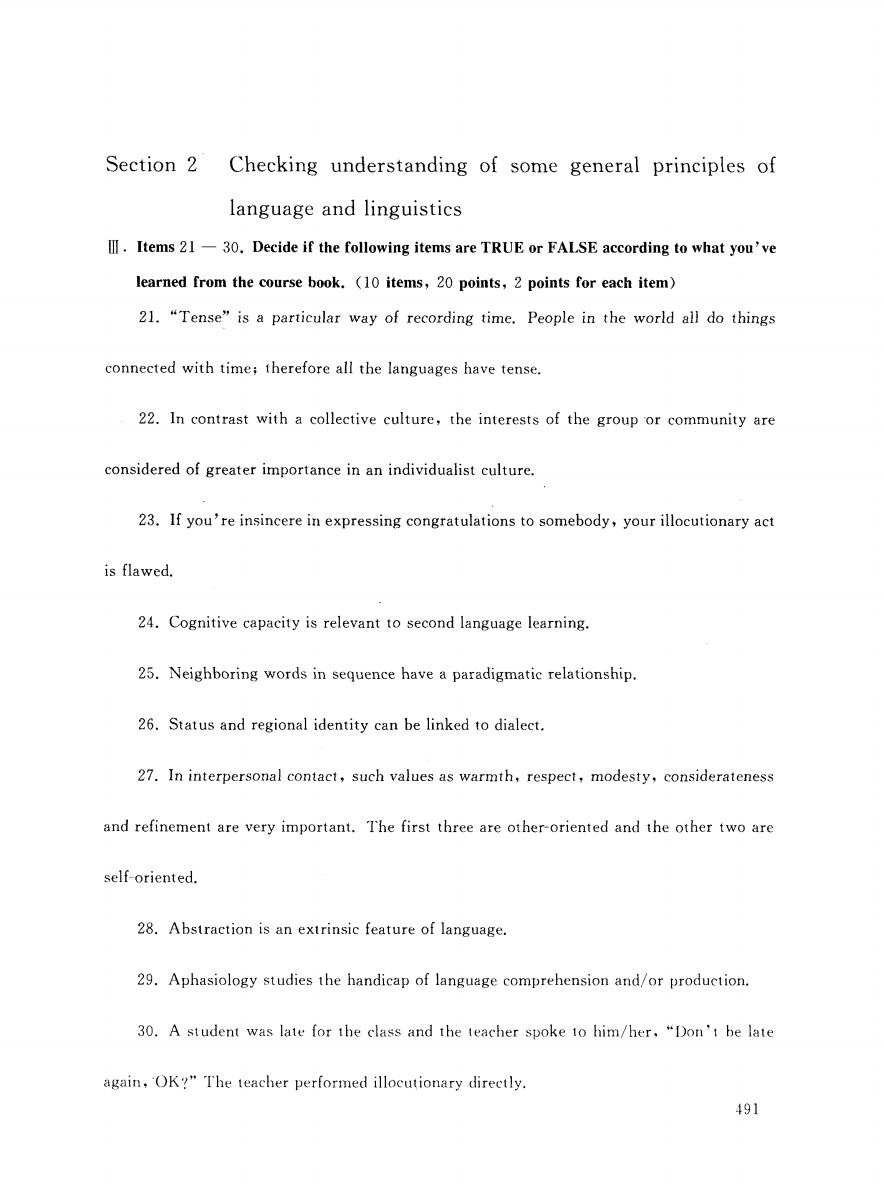
Section 2 Checking understanding of some general principles of language and linguistics III.Items 21-30.Decide if the following items are TRUE or FALSE according to what you've learned from the course book.(10 items,20 points,2 points for each item) 21."Tense"is a particular way of recording time.People in the world all do things connected with time;therefore all the languages have tense. 22.In contrast with a collective culture,the interests of the group or community are considered of greater importance in an individualist culture. 23.If you're insincere in expressing congratulations to somebody,your illocutionary act is flawed. 24.Cognitive capacity is relevant to second language learning. 25.Neighboring words in sequence have a paradigmatic relationship. 26.Status and regional identity can be linked to dialect. 27.In interpersonal contact,such values as warmth,respect,modesty,considerateness and refinement are very important.The first three are other-oriented and the other two are self-oriented. 28.Abstraction is an extrinsic feature of language. 29.Aphasiology studies the handicap of language comprehension and/or production. 30.A student was late for the class and the teacher spoke to him/her,"Don't be late again,OK?"The teacher performed illocutionary directly. 491
Section 2 Checking understanding of some general principles of language and linguistics 1.Items 21一 30. Decide if the following items are TRUE or FALSE according to what you've learned from the course book.(10 items, 20 points, 2 points for each item) 21. "Tense" is a particular way of recording time. People in the world all do things connected with time;therefore all the languages have tense. 22. In contrast with a collective culture, the interests of the group 'or community are considered of greater importance in an individualist culture. 23. If you’re insincere in expressing congratulations to somebody, your illocutionary act is flawed. 24. Cognitive capacity is relevant to second language learning. 25. Neighboring words in sequence have a paradigmatic relationship. 26. Status and regional identity can be linked to dialect. 27. In interpersonal contact,such values as warmth, respect, modesty, considerateness and refinement are very important. The first three are other-oriented and the other two are self-oriented. 28. Abstraction is an extrinsic feature of language. 29. Aphasiology studies the handicap of language comprehension and/or production. 30. A student was late for the class and the teacher spoke to him/her,"Uon’t be late again,UK`?" "hhe teacher performed illocutionary directly

IV.Items 31--40.Read the questions in Column A and choose the right one from Column B to answer each of them.Write the corresponding letter on the ANSWER SHEET.There is ONLY one answer for each question.(10 items,20 points,2 points for each item) 31.When introducing each other in Chinese,people A.A restaurant script often say: B.Bilingualism “一您贵姓?” C.Expressing his opinion “一免贵姓王。” D.A critical period Which politeness maxim does the conversation E.The maxim of self- represent? denigration and 32."Cloud"as a word is related to the object it stands for in other-elevation the mind that understand it. F.A lateralization period What linguistic relations do the statement exemplify? G.Giving excuses 33.“一块二一斤?够贵的。” H.Paradigmatic relation By saying this,what illocutionary speech act is the I.The speaker-perspective speaker performing? J.Taboo Expressions 34.“您大人有大量,就别往心里去了。” K. Interpersonal From which perspective does the speaker apologize? language 35.“My next appointment is waiting.” pattern By saying in this way,which one of the safe ways does L.The victim-perspective the speaker follow to close the conversation? M.Strike a good bargain 36.In Chinese,instead of saying“死了”,we use“过去了” N.Schema knowledge or“去世了”. O.Triadic relations Which linguistic aspect do these expressions exemplify? P.Euphemism 37.lnUS,“Grownup Chinese speak Chinese.”“Grownup Q.Showing consideration Americans speak English.”“All Children speak R.Managing interpersonal English..” relations with language Which Linguistic aspect do these quotations represent? S. The maxim of using 38.A Chinese student may find it difficult to dine in a address terms western restaurant. T.Language and power What sort of linguistic knowledge does the student lack? 39."At the age of two,the two hemispheres began to show signs of separation in functions and the process ended at puberty..” According to the hypothesis,what is the period from age 2 to puberty called? 40.Which linguistic aspect does the saying“名不正则言不 顺”imply? 492
W.Items 31 -40. Read the questions in Column A and choose the right one from Column B to answer each of them. Write the corresponding letter on the ANSWER SHEET, There is ONLY one answer for each question,(10 items, 20 points, 2 points for each item) 31. When introducing each other in Chinese, people often say: “一您贵姓?” “一免贵姓王。” Which politeness maxim does the conversation represent? 32. "Cloud" as a word is related to the object it stands for in the mind that understand it. What linguistic relations do the statement exemplify? 33.“一块二一斤?够贵的。” By saying this,what illocutionary speech act is the speaker performing? 34.“您大人有大量,就别往心里去了。” From which perspective does the speaker apologize? 35.“My next appointment is waiting.” By saying in this way, which one of the safe ways does thespeaker follow to close the conversation? 36, In Chinese, instead of saying“死了”,we use“过去了” or“去世了”. Which linguistic aspect do these expressions exemplify? 37. In US, "Grownup Chinese speak Chinese.”“Grownup Americans speak English.” “ All Children speak English.” Which Linguistic aspect do these quotations represent? 38. A Chinese student may find it difficult to dine in a w estern restaurant. What sort of linguistic knowledge does the student- lack? 39.“At the age of two,the two hemispheres began to show signs of separation in functions and the process ended at puberty.” According to the hypothesis,what is the period from age 2to puberty called? 40. Which linguistic aspect does the saying“名不正则言不 Uf}”imply? 492 A. A restaurant script B. Bilingualism C. Expressing his opinion D. A critical period E. The maxim denigration other-elevation of self- and F, A lateralization period G. Giving excuses H. Paradigmatic relation I. The speaker-perspective J. Taboo Expressions K. Interpersonal language pattern L. The victim-perspective M. Strike a good bargain N. Schema knowledge O. Triadic relations P. Euphemism Q, Showing consideration R. Managing interpersonal relations with language S. The maxim of using address terms "r. Language and power
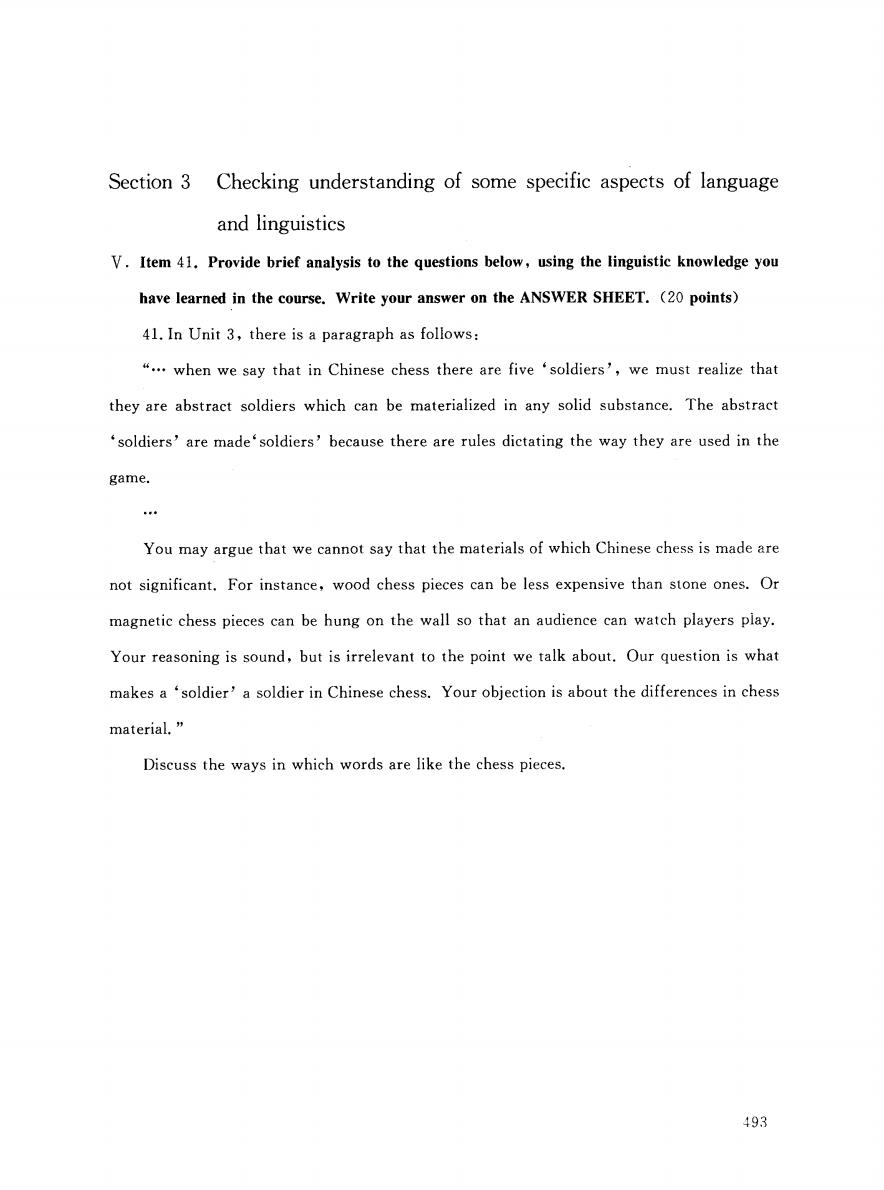
Section 3 Checking understanding of some specific aspects of language and linguistics V.Item 41.Provide brief analysis to the questions below,using the linguistic knowledge you have learned in the course.Write your answer on the ANSWER SHEET.(20 points) 41.In Unit 3,there is a paragraph as follows: ".when we say that in Chinese chess there are five 'soldiers',we must realize that they are abstract soldiers which can be materialized in any solid substance.The abstract 'soldiers'are made'soldiers'because there are rules dictating the way they are used in the game. You may argue that we cannot say that the materials of which Chinese chess is made are not significant.For instance,wood chess pieces can be less expensive than stone ones.Or magnetic chess pieces can be hung on the wall so that an audience can watch players play. Your reasoning is sound,but is irrelevant to the point we talk about.Our question is what makes a'soldier'a soldier in Chinese chess.Your objection is about the differences in chess material.” Discuss the ways in which words are like the chess pieces. 493
Section 3 Checking understanding of some and linguistics specific aspects of language V.Item 41. Provide brief analysis to the questions below,using the linguistic knowledge you have learned in the course. Write your answer on the ANSWER SHEET. (20 points) 41. In Unit 3,there is a paragraph as follows: “… when we say that in Chinese chess there are five‘soldiers,,we must realize that they are abstract soldiers which can be materialized in any solid substance. The abstract soldiers' are made`soldiers’because there are rules dictating the way they are used in the gam e. You may argue that we cannot say that the materials of which Chinese chess is made are not significant. For instance, wood chess pieces can be less expensive than stone ones. Or magnetic chess pieces can be hung on the wall so that an audience can watch players play. Your reasoning is sound,but is irrelevant to the point we talk about. Our question is what makes a‘soldier' a soldier in Chinese chess. Your objection is about the differences in chess material.” Discuss the ways in which words are like the chess pieces. 493

试卷代号:1066 座位号工1 中央广播电视大学2007一2008学年度第二学期“开放本科”期末考试 语言与应用语言学试题答题纸 2008年7月 题 号 Section Section 2 Section 3 总分 分 数 Section 1 Checking content awareness of the course 得 分 评卷人 I.Items 1-10(20 points,2 points for each item.) 得分 得分 2 得分 得分 得分 5 得分 6 得分 得分州 得分 得分 10 得 分 评卷人 II.Items 11-20 (20 points,2 points for each item. 得分 得分 得分 得分州 得分 15 得分 6 得分 得分 得分 9 得分 20. Section 2 Checking understanding of some general principles of language and linguistics 得 分 评卷人 Ⅲ,Items21一30(20 points,2 points for each item.) 得分 得分 22. 得分州 23 得分 24 得分 25. 得分 26. 得分 27 得分 28 得分 29 得分 30. 494
试卷代号:1066 座位号口 中央广播电视大学2007-2008学年度第二学期“开放本科”期末考试 语言与应用语言学 试题答题纸 2oog年 z月 题 号 Section 1 Section 2 Section 3 I I m N V 总 分 分 数 Section 1 Checking content awareness of the course 得 分 评卷人 I.Items 1一10 (20 points,2 points for each item.) }}州 } k}州 } }}州 } k}州 } }T}州 } h}州 1 }}州 } }}州 1 得 分 评卷人 I.Items 11一20 (20 points,2 points for 10 11 k}州 } k}州 } 12 13 14 15 16 17 h}州 } }得州’}18 k}州 } }得州 }19 k}州 } k}州 120 Checking understanding of some general principles of language and linguistics 得 分 评卷人 l m.Items 21一30 (20 points,2 points for each item. }}州 } }得州 } 21 }得州 } {得分一{ 22 }得分一} }得州 } 23 24 25 26 27 28 }}州 1 1得分】}29 }}州 1 C'} 5} }30 494
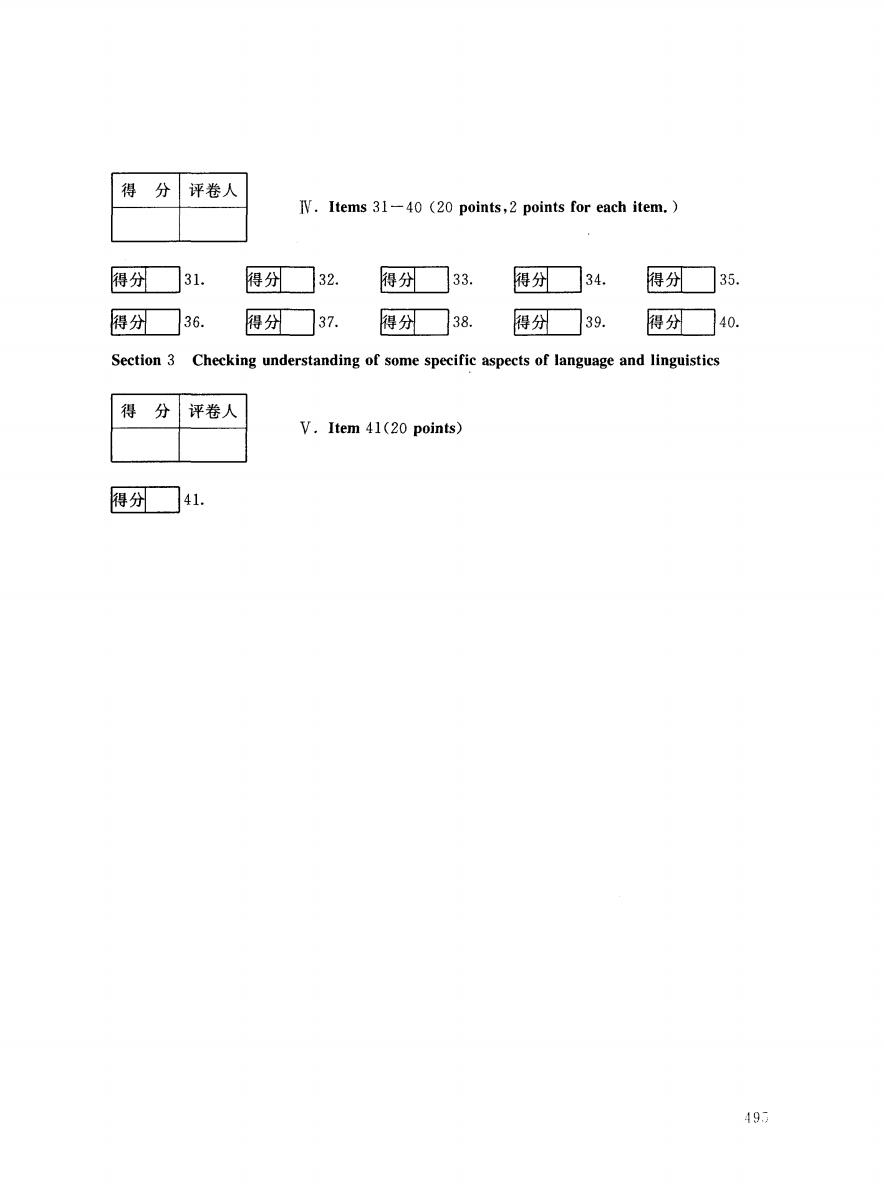
得分 评卷人 IV.Items 31-40 (20 points,2 points for each item. 得分 31. 得分 32 得分州 33. 得分 34. 得分 35. 得分 36. 得分 37. 得分 38. 得分 39. 得分 40. Section 3 Checking understanding of some specific aspects of language and linguistics 得分 评卷人 V.Item 41(20 points) 得分41. 49
得 分 评卷人 W.Items 31一40 (20 points,2 points for each item. 31 32 33 34 35 36 }} } k}州”}37 k}钟 ! k州 }38 }}州.! }}}州 ’}39 k} } k}州 }40 Checking understanding of some specific aspects of language and linguistics 得 分 评卷人 V.Item 41(20 points) k}州 }41. 通9二

试卷代号:1066 中央广播电视大学2007一2008学年度第二学期“开放本科”期末考试 语言与应用语言学 试题答案及评分标准 (供参考) 2008年7月 Section 1 Checking content awareness of the course I.Items 1-10 (10 items,20 points,2 point for each item) 1.C 2.D 3.C 4.B 5.A 6.C 7.C 8.D 9.B 10.A II.Items 11-20(10 items,20 points,2 point for each item) ·11.F 12.H 13.B 14.K 15.G 16.A 17.E 18.C 19.L 20.D Section 2 Checking understanding of some general principles of language and linguistics II.Items 21-30 (10 items,20 points,2 point for each item) 21.F 22.F 23.T 24.T 25.F 26.T 27.F 28.F 29.T 30.F IV.Items 31-40 (Questions 31-40:20 points,2 points for each item) 31.E 32.0 33.C 34.L 35.G 36.P 37.K 38.A 39.D 40.R Section 3 Checking understanding of some specific aspects of language and linguistics V.(20 points) (问题) 41.In Unit 3,there is a paragraph as follows: "..when we say that in Chinese chess there are five 'soldiers',we must realize that 496
试卷代号:1066 中央广播电视大学2007-2048学年度第二学期“开放本科”期末考试 语言与应用语言学 试题答案及评分标准 (供参考) 2008年 7月 Section 1 Checking content awareness of the course I.Items 1一10(10 items, 20 points, 2 point for each item) 1. C 6. C 2. D 3. C 4.B 5. A 7. C 8. D 9. B 10. A n.Items 11一20(10 items, 20 points, 2 point for each item) 11. F 16. A 12. H 17. E 13. B 18. C 14, K 19. L 15. G 20. D Section 2 Checking understanding of language and linguistics som e general principles of m.Items 21一30(10 items, 20 points, 2 point for each item) 减任 0 口 0 乙 9 户 21. F 26. T 22. F 27. F 23. T 28. F 25. F 30. F N.Items 31一40 (Questions 31一40:20 points,2 points for each item) 31. E 36. P 32. O 37. K 33. C 38. A G 尸0 八曰 勺d J’l什 ‘“比 O J Q 曰 勺 d Section 3 Checking understanding of some specific aspects of language and linguistics V.(20 points) (问题 ) 41. InUnit 3,there is a paragraph as follows: “… when we say that in Chinese chess there are five‘soldiers’,we must realize that 496